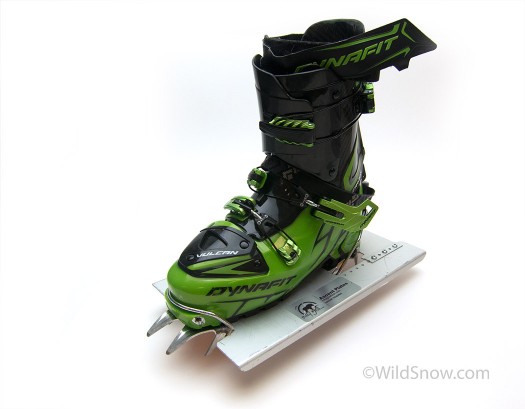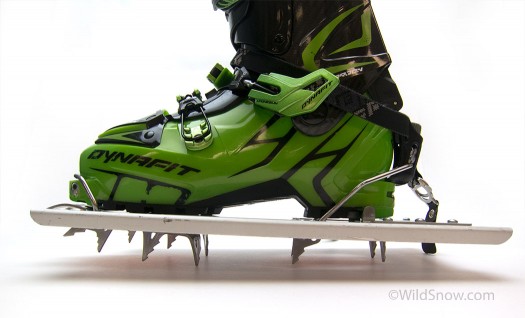The steep and deep. There’s a reason those words sound so good together. Skiing pow down a steep, big line is like nothing else. Unfortunately, to get down, you gotta get up, and that’s the hard part, especially if you’re climbing what you’re skiing. I can’t count the number of times over the years where I’ve had to wallow up some steep couloir, and progress has slowed to a crawl. Step, sink, step, sink. It’s heinous.
For years I’ve avoided such ascents as much as possible, either by going around, or letting someone else go first. Planning on going to Alaska, however, meant climbing steep pow couldn’t be avoided. For years Vert snowshoes have been the gold standard for Alaska steep-pow booters, and I’ve considered getting some for a while. I was hesitant given their bulk, and the fact that they can quickly become a dangerous handicap if hard snow or rocks are encountered underneath the pow. I found Billygoat Technologies’ website while cruising around the internet, and their Ascent Plates seemed like a perfect solution.
Ascent plates are fairly simple. They consist of an aluminum plate that fits between your crampon and ski boot providing extra surface area and flotation. The fact that the plate uses the crampon as an attachment reduces weight, and also provides extra security on hard snow or rocks. The plate can be adjusted to a variety of crampon sizes through a series of screws and holes.
I didn’t have a chance to use the plates before heading up to Alaska, other than tromping around on my carpet. On our trip we had two sets of Ascent Plates, as well as a set of Verts, that Drake kindly let us borrow (Thanks!). I used the Verts for a few days, and the Ascent Plates for a few days, since I really didn’t have any experience with either.

With some crampons, including my Black Diamonds, the Ascent Plates don't quite sit flat. It doesn't effect the function, however it means that the crampons must be adjusted when using without the plates.
The Ascent Plates proved to be incredibly useful, even essential. At least one line we hiked was so steep and powdery that I doubt it would have been possible with out the extra flotation. At first the plates were a little difficult to put on, especially in a precarious location. However after a few climbs, I found that they can be put on fairly quickly, almost as fast as normal crampons. The crampon points are super useful. I encountered a few spots where there were some crusts, or rocks underneath the snow, and as long as the crampons were kept perpendicular to the slope, the front points worked perfectly. The burly aluminium plates are fairly heavy, however they quickly make up for the weight after a few steps in deep powder. That being said, they would be quite a heavy item to carry if you weren’t sure they were going to be necessary.
The Ascent plates also come in a variety that is specifically for soft boots, such as snowboard boots. They utilize the same basic concept, with the addition of some gripy spikes attached to the top of the plate. Coop and Tyler used these, and found they worked just as well on snowboard boots. I even tried them a bit on ski boots, and they seemed to work perfectly.
I used some Verts, pretty much the only similar product on the market, on the trip as well. There were some advantages to both. The Verts feel a little lighter on the feet, and are bigger, so they give better flotation. However, the Ascent Plates are lighter (although the Ascent Plate/crampon combo is heavier on the feet) if you are already carrying crampons, which is usually the case. The plates also pack down tighter in the pack. Also, the security provided by the crampons is essential.
Although they are definitely a specialty item, and I won’t be carrying them on every backcountry trip, the Ascent Plates are awesome. They really were worth their weight in Alaska, and I can see myself using them on some other objectives as well. The design is simple and ingenious.
Billygoat Ascent Plates can be purchased here.
Louie Dawson earned his Bachelor Degree in Industrial Design from Western Washington University in 2014. When he’s not skiing Mount Baker or somewhere equally as snowy, he’s thinking about new products to make ski mountaineering more fun and safe.



